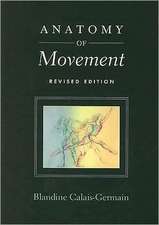Eccentric Exercise: Physiology and application in sport and rehabilitation: Routledge Research in Sport and Exercise Science
Autor Hans Hoppeleren Limba Engleză Paperback – iun 2016
In Eccentric Exercise, leading international sport scientist Hans Hoppeler introduces the fundamental physiology and pathophysiology of eccentric muscle work, and explores the key applications of eccentric exercise in sport, rehabilitation and health. The book examines the molecular mechanisms responsible for tissue and organismic adaptations and discusses eccentric muscle-related pathology, specifically delayed onset muscle soreness. It assesses the use of eccentric exercise training in the treatment of certain disease states such as chronic obstructive pulmonary disease, heart insufficiency and sarcopenia, while a concluding chapter points to open research questions, shows the limits of the available data and highlights problems with current exercise modalities.
This book is important reading for all sport and exercise scientists, clinicians working in rehabilitation, and high-level strength and conditioning coaches and trainers.
| Toate formatele și edițiile | Preț | Express |
|---|---|---|
| Paperback (1) | 389.40 lei 6-8 săpt. | |
| Taylor & Francis – iun 2016 | 389.40 lei 6-8 săpt. | |
| Hardback (1) | 1221.93 lei 6-8 săpt. | |
| Taylor & Francis – 27 aug 2014 | 1221.93 lei 6-8 săpt. |
Din seria Routledge Research in Sport and Exercise Science
-
 Preț: 491.26 lei
Preț: 491.26 lei -
 Preț: 464.76 lei
Preț: 464.76 lei - 5%
 Preț: 469.36 lei
Preț: 469.36 lei -
 Preț: 462.60 lei
Preț: 462.60 lei -
 Preț: 419.11 lei
Preț: 419.11 lei -
 Preț: 484.47 lei
Preț: 484.47 lei -
 Preț: 385.47 lei
Preț: 385.47 lei - 34%
 Preț: 251.94 lei
Preț: 251.94 lei -
 Preț: 416.22 lei
Preț: 416.22 lei -
 Preț: 414.32 lei
Preț: 414.32 lei -
 Preț: 416.44 lei
Preț: 416.44 lei - 5%
 Preț: 403.63 lei
Preț: 403.63 lei -
 Preț: 386.00 lei
Preț: 386.00 lei -
 Preț: 385.18 lei
Preț: 385.18 lei - 20%
 Preț: 333.69 lei
Preț: 333.69 lei - 20%
 Preț: 271.20 lei
Preț: 271.20 lei -
 Preț: 394.12 lei
Preț: 394.12 lei -
 Preț: 382.91 lei
Preț: 382.91 lei -
 Preț: 167.17 lei
Preț: 167.17 lei - 17%
 Preț: 256.13 lei
Preț: 256.13 lei -
 Preț: 389.38 lei
Preț: 389.38 lei -
 Preț: 311.18 lei
Preț: 311.18 lei -
 Preț: 381.89 lei
Preț: 381.89 lei - 18%
 Preț: 1000.27 lei
Preț: 1000.27 lei - 18%
 Preț: 1053.33 lei
Preț: 1053.33 lei
Preț: 389.40 lei
Preț vechi: 409.90 lei
-5% Nou
Puncte Express: 584
Preț estimativ în valută:
74.51€ • 77.80$ • 61.53£
74.51€ • 77.80$ • 61.53£
Carte tipărită la comandă
Livrare economică 15-29 aprilie
Preluare comenzi: 021 569.72.76
Specificații
ISBN-13: 9781138695221
ISBN-10: 113869522X
Pagini: 212
Ilustrații: 57
Dimensiuni: 156 x 234 x 17 mm
Greutate: 0.3 kg
Ediția:1
Editura: Taylor & Francis
Colecția Routledge
Seria Routledge Research in Sport and Exercise Science
Locul publicării:Oxford, United Kingdom
ISBN-10: 113869522X
Pagini: 212
Ilustrații: 57
Dimensiuni: 156 x 234 x 17 mm
Greutate: 0.3 kg
Ediția:1
Editura: Taylor & Francis
Colecția Routledge
Seria Routledge Research in Sport and Exercise Science
Locul publicării:Oxford, United Kingdom
Public țintă
Postgraduate and UndergraduateCuprins
1. Muscle Structure and Function 2. Modes of Muscle Contraction 3. Properties of Eccentric Contractions 4. Eccentric Exercise in Resistance Training 5. Moderate Load Eccentric Exercise 6. The Role of Eccentric Exercise Training in Alpine Skiers 7. Eccentric Exercise in Orthopedic Rehabilitation and Injury Prevention 8. Eccentric Exercise in Medical Conditions with Muscle Wastage.
Notă biografică
Hans Hoppeler was born in Switzerland in 1948, is married, has four adult children and lives in Bern. He studied Medicine at the University of Bern and worked as an MD at the Hospital of Burgdorf for three years before taking up an academic career. His main research interests are the plasticity of skeletal muscle tissue from the molecular to motion, as well as the design of the respiratory system. He has authored or co-authored over 300 publications, which have been cited over 10,000 times. He is a member of the Leopoldina and the Swiss Academies of Medical Sciences.
Descriere
In Eccentric Exercise, leading international sport scientist Hans Hoppeler introduces the fundamental physiology and pathophysiology of eccentric muscle work, and explores the key applications of eccentric exercise in sport, rehabilitation and health. The book examines the molecular mechanisms responsible for tissue and organismic adaptations and discusses eccentric muscle-related pathology, specifically delayed onset muscle soreness. It assesses the use of eccentric exercise training in the treatment of certain disease states such as chronic obstructive pulmonary disease, heart insufficiency and sarcopenia, while a concluding chapter points to open research questions, shows the limits of the available data and highlights problems with current exercise modalities.
This book is important reading for all sport and exercise scientists, clinicians working in rehabilitation, and high-level strength and conditioning coaches and trainers.
This book is important reading for all sport and exercise scientists, clinicians working in rehabilitation, and high-level strength and conditioning coaches and trainers.






















